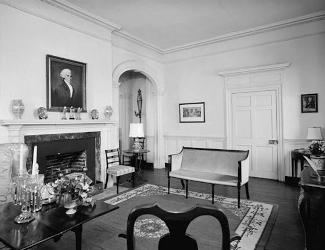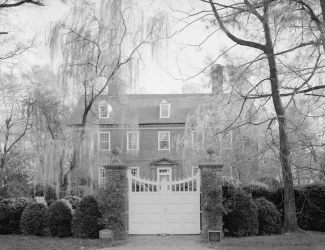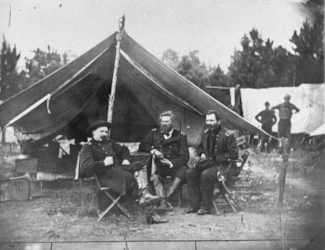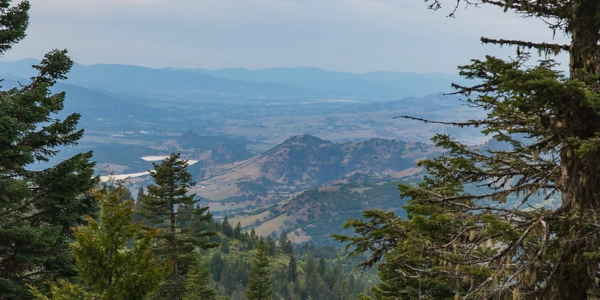
Image above: Pathway looking south from the mansion toward the James River, 1981, Jet Lowe, Historic American Buildings Survey. Courtesy Library of Congress.
Spotlight on Lesser Known History
Berkeley Plantation, Virginia
America's Best History Spotlight
On this page we're going to Spotlight the lesser known historic sites and attractions that dot the history landscape across the USA and are worth a visit if you're in their area. And while they may be lesser known, some are very unique, and will be that rare find. You'll be, at times, on the ground floor, or maybe even know something others don't. It'll be fun. Visit them.

Berkeley Plantation, Virginia
On December 4, 1619, thirty-eight members of the Virginia Company of London settled on the north bank of the James River twenty miles north of their brethren at Jamestown. They held the first Thanksgiving that same night. Oh, yes, there's the first controversy. And it's one that Berkeley Hundred seems to have lost in the public discourse to those Pilgrims and their Thanksgiving a couple years later at Plymouth with their Indian brethren. Oh, well. Berkeley would move forward with the claim, be home, birthplace, or legacy to a few presidents (think Harrison), then play a role in the 1862 Peninsula campaign of the Civil War. Today you can visit about six hundred and fifty acres of the original eight thousand acres; the mansion has been a museum, privately run, since the 1940's. Open spring to fall. Image above: View of the front of the Berkeley Plantation mansion, 1981, Jet Lowe, Historic American Buildings Survey. Courtesy Library of Congress.
Sponsor this page for $100 per year. Your banner or text ad can fill the space above.
Click here to Sponsor the page and how to reserve your ad.
Info, What's There Now, History Nearby

Berkeley Plantation, Virginia
In 1618, the Virginia Company of London gave a land grant to Sir William Throckmorton, Sir George Yeardley, George Thorpe, Richard Berkeley, and John Smyth of Nibley. The settlement would be named after Berkeley. They left Bristol, England on the ship Margaret and arrived on December 4, 1619, and were immediately instructed, "the day of our ships arrival ... shall be yearly and perpetually kept as a day of Thanksgiving." Therefore, the controversy. But the Berkeley Hundred survived in relative peace for three years until Opchanacanough, chief of the Powhatan Confederacy, decided for war against the James River settlements. Nine at Berkeley Hundred were killed with most of the remainder abandoning the settlement for Jamestown.
That would change, of course, with resettlement in 1636, becoming part of the lands of John Bland, then his son Giles. Giles chose to participate in Bacon's Rebellion; Governor William Berkeley chose to see that as treason, and thus his hanging.
Better days would come. The Harrisons, of political fame, would purchase the property in 1691, Benjamin III. He would use it as a commercial shipyard for sending tobacco to England and later, during the time of strife, the Harrison's would build eighteen warships for the Revolutionary Navy. The mansion would be built during the Harrison era, in 1726, by Benjamin Harrison IV, in its Georgian style, using bricks made on the plantation itself. The initials of Benjamin and wife Anne are over a side door on a datestone. Look for it if you visit.
Image above: Rear of the main house and two other houses on Berkeley Plantation on the rear side from the James River, 1934/1935, Albert S. Burns, Historic American Buildings Survey. Courtesy Library of Congress. Below: Front view of the Manor House, 2019, Carol M. Highsmith. Courtesy Library of Congress.

Where Is It
Berkeley Plantation is located on Route 5, John Tyler Memorial Highway, about twenty-five miles west of Richmond, almost equidistant from Williamsburg, which is thirty miles east on Route 5.
What is There Now
Berkeley Plantation of the Berkeley Hundred colony consists of hundreds of acres, a gift shop in an original outbuilding, house tours and grounds tours, and a museum. There is a short film and artifacts of Colonial and Civil War artifacts in the museum. They suggest at least having two hours to tour it all. Reconstructed slave cabins were added during the filming of Harriet Tubman's movie, Harriet.
There are ten acres of formal gardens, plus a picnic area for visitors.
When Open and How Much
Open year round, except deep winter months in 2022. Reopens March 19, 2022, and costs $15 for adults, and $7 for children from 6-12. Other discounts may apply.
Fees subject to change.
Websites
Berkeley Plantation
History Nearby
You're in quite close company to so many American Revolution, colonial, and Civil War sites that it's hard to choose which to highlight. But let's start with a couple nearby.
Buy Chronology

Great Book for the History Fan with Fifty Short Essays Telling the Story of American History.
Photos, History, and More Spotlights

Presidential History
Much of the Presidential history lies in the Georgian Mansion, the oldest three story brick building in Virginia. Built by Benjamin Harrison IV, their son Benjamin V, was born there, later attend William and Mary College and spend twenty-five years in the Virginia House of Burgesses. When revolution struck, he became a delegate to the Continental Congress and was thought highly, reading the draft of the Declaration of Independence, written by Jefferson, to the assembly on July 1. He was one of the fifty-six signers.
He served as a lieutenant in the County Militia and after the war ended, was elected Governor of Virginia in 1781.
Benjamin Harrison VI was born on the plantation and took over its operation in 1790. Prior to that, he had been the the Deputy Paymaster of the Continental Army. Benjamin Harrison VII was the last Harrison to own Berkeley, as financial hardship hit the plantation due to poor farming practices, but that would not end its legacy.
William Henry Harrison was born at Berkeley, the youngest son of Benjamin V. He would join the Army and serve in the Northwest Indian Wars, become famous at the Battle of Tippecanoe, then become the ninth President of the United States. He would serve only thirty-two days; pneumonia causing the shortest tenure of a president in history.
However, the legacy started at Berkeley Hundred did not end for the Harrison's; his grandson, Benjamin Harrison, would become the 23rd President of the United States on March 4, 1889.
Photo above: Interior of the northeast living room parlor at the Berkeley Mansion, 1981, Jet Lowe, Historic American Buildings Survey. Courtesy Library of Congress.

On the Grounds Today
While the Georgian Mansion from 1726 takes most of the focus due to its grandeur and placement high on the hills above the James River, the significant outbuilding now housing the gift shop holds its own as a place to wander. Boxwood trees and formal gardens dot the grounds. For those that like to wonder, look over the James River now and try to imagine the building of warships for the Continental Navy extending on piers from the shoreline.
During a tour of the grounds, there are brick structures that tell different stories; one of the first Thanksgiving, others of the encampment of the Union Army. There are pavilions for decoration as well as tables to picnic.
While the original slave cabins are long gone. There were one hundred and ten slaves listed under the ownership of Benjamin Harrison V. Reconstructed cabins now exist from the filming of the Harriet Tubman movie, "Harriet" in the approximate location of the original.
Photo above: Pavilion on the Berkeley Plantation grounds, 2019, Carol M. Highsmith. Courtesy Library of Congress.

Other History of Berkeley Plantation
The first ten presidents of the United States at one time visited Berkeley Plantation. During the Civil War, Union troops occupied the grounds during the Peninsula campaign of 1862. Abraham Lincoln visited General McClellan twice there. But perhaps even more famous was the writing, or rewriting, of the iconic tune to Taps by General Daniel Butterfield and his bugler Olive Willcox Norton while stationed at Harrison's Landing after the Seven Days Battles of the Peninsula campaign. There's controversy in the that story, too, as other accounts of the current version of Taps exist.
John Jamieson, a lumber baron, bought the rundown property in 1907; his son Malcom restored the mansion and grounds in 1925, occupying it again as a residence in 1938. In the 1940's, the Jamiesons began opening the residence to the public as a private enterprise. It was the first of the James River Plantations to do that.
Photo above: Black and white photo of the north side of the mansion, 1981, Jet Lowe, Historic American Buildings Survey. Library of Congress. Below: Union General John Sedgewick and staff on the plantation grounds during the 1862 Peninsula campaign of the Civil War, 1862, David B. Woodbury. Courtesy Wikipedia Commons.


T-Shirts and Gifts from the official souvenirs of Americasbesthistory.com.
About
America's Best History where we take a look at the timeline of American History and the historic sites and national parks that hold that history within their lands.
Photos courtesy of the Library of Congress, National Archives, National Park Service, americasbesthistory.com and its licensors.
- Contact Us
- About
- © 2022 Americasbesthistory.com.
Template by w3layouts.


